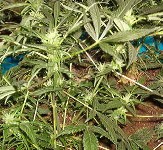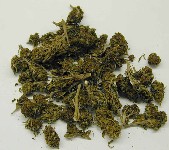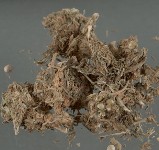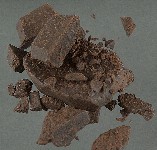    Cannabis is one of the most extensively used recreational drugs in Canada. In October 2018 Canada became the first developed nation to legalize its use. Cannabis, from the Cannabis sativa plant (see a large photo), is a mood-altering drug, and can be found in marijuana (the dried seeds and leaves of the plant ... see another large photo), as well as hashish (see a large photo) and hash oil (both from the plant resin). Marijuana and hashish are usually smoked, most commonly in cigarettes or vape devices, since legalization in Canada. Cannabis can also be obtained in candy form, or cooked in foods. As of 2022 in Canada: 66% of users purchase cannabis in dried flower or leaf form 53% purhase edibles 29% use vape pens 26% use cannabis oil orally The cannabis 'high' comes from the chemical THC , or delta-9-tetrahydro-cannabinol. Hashish usually contains more of this active ingredient than marijuana, and hash oil even more. Cannabis use makes you feel more relaxed; colours seem brighter, sounds and smells seem more distinct. Some users feel happy and talk a lot; others become quiet and withdrawn. These effects usually last for two to four hours. If you eat it, the effects take longer to occur, but last longer. Cannabis use affects your judgment, and slows your reaction time dramatically. Driving and operating machinery while using this drug is definitely not safe, and illegal, especially if its use is combined with alcohol, which it often is. While high on cannabis, you lose some of your ability to learn. You forget things, and have trouble concentrating. Some users suffer from severe anxiety, and high doses can cause panic attacks and temporary psychosis. However, these effects usually disappear within hours. Cannabis can still be obtained in unregulated form, illegally, and users have no idea what other chemicals they may be getting when they purchase cannabis. Often it is spiked with other nasty substances to increase its 'kick'. Legally obtained cannabis, however, is tightly regulated and unadulterated. Marijuana can be taken to decrease the nausea caused by anti-cancer drugs, and to increase appetite in people with AIDS. Using cannabis heavily for a long time can have serious side effects:
|